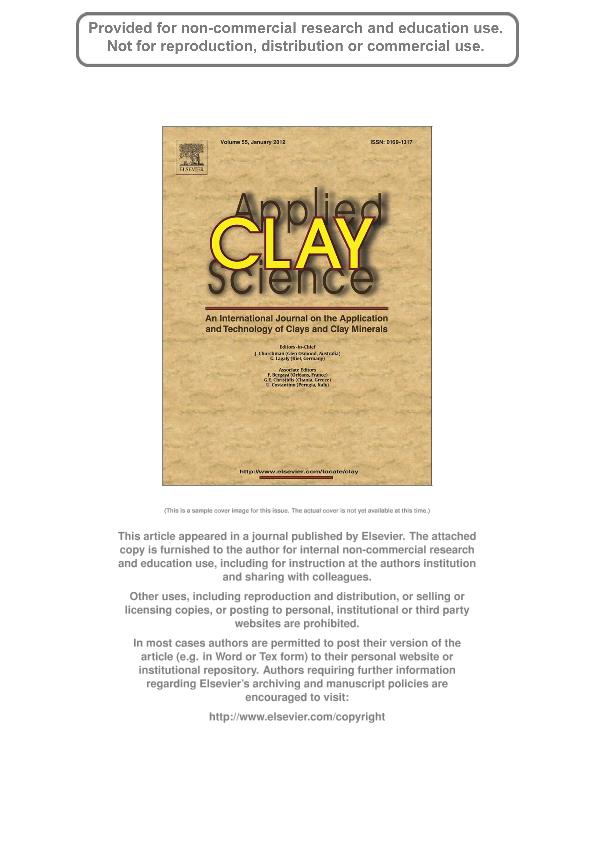Mostrar el registro sencillo del ítem
dc.contributor.author
Franchini, Marta Beatriz

dc.contributor.author
Impiccini, Agnes

dc.contributor.author
Beaufort, Daniel
dc.contributor.author
Patrier, Patrice
dc.contributor.author
Anderson, Corby
dc.contributor.author
Pons, María Josefina

dc.date.available
2022-04-04T15:21:15Z
dc.date.issued
2012-10
dc.identifier.citation
Franchini, Marta Beatriz; Impiccini, Agnes; Beaufort, Daniel; Patrier, Patrice; Anderson, Corby; et al.; Mineral assemblages and distribution of phyllosilicates composition along the main section of the Agua Rica deposit, Catamarca, Argentina: Implications for future mine development; Elsevier Science; Applied Clay Science; 67-68; 10-2012; 61-71
dc.identifier.issn
0169-1317
dc.identifier.uri
http://hdl.handle.net/11336/154274
dc.description.abstract
Agua Rica (27°26′S–66°16′O) is a world class Cu (Mo–Au) deposit located in Catamarca, Argentina, in which the porphyry and high sulfidation epithermal stages usually distant 1 km vertically, are located at the same level of erosion. Seventy one samples and 120 phyllosilicates were analyzed from the study section (E–W 6969400 N) to determine distinctive mineralogical zones which differ not only by their hydrothermal history but also by their potential behavior during the ore processing operations via flotation. In the east side of the section, biotite K1.78–1.67 Na0.05–0.02(Al0.42–0.00Mg3.77–3.22Fe1.46–1.00Ti0.90–0.18Mn0.02–0.01) (Si5.42–4.82Al3.18–2.58) (OHF1.90–1.40Cl0.06–0.04)4 of the early, high temperature potassic alteration (>550 °C to 370 °C) is encapsulated in a phyllic halo dominated by illite K1.73–1.08 Na0.10–0.0(Al3.96–3.49Mg0.36–0.03Fe0.25–0.01Ti0.06–0.0) (Si6.53–6.07Al1.93–1.47) (OHF0.54–0.0Cl0.02–0.0)4+quartz+pyrite+covellite+molybdenite+rutile. This mineral assemblage formed from fluids with temperatures≤350 °C that attained high sulfur fugacity. The clasts of the hydrothermal and mineralized breccia bodies located at the center of the section and to the east contain widespread pyrophyllite K0.05–0.0(Al4.07–3.94Fe0.12–0.01)(Si7.92–7.50Al0.50–0.05)(OHF0.15–0.02Cl0.03–0.0)4 that had replaced illite at temperatures between 360 °C and 280 °C. Minor amounts of dickite and widespread kaolinite occur in the advanced argillic and phyllic halos, respectively, as late minerals in clots or in veinlets thus, fluids cooled enough (b270° and b200 °C, respectively) for their formation. The presence of phyllosilicate minerals is a potential cause of loss in recovery of copper and molybdenite during the flotation process. Carefully planned and controlled comprehensive liberation and flotation testing should be undertaken in conjunction with mineralogical analysis to optimize and quantify recoveries, separations, grades and gangue deportment.
dc.format
application/pdf
dc.language.iso
eng
dc.publisher
Elsevier Science

dc.rights
info:eu-repo/semantics/openAccess
dc.rights.uri
https://creativecommons.org/licenses/by-nc-sa/2.5/ar/
dc.subject
PORPHYRY
dc.subject
CU-MO
dc.subject
HIGH
dc.subject
SULFIDATION
dc.subject
EPITHERMAL
dc.subject
POLYMETALLIC
dc.subject
DEPOSIT
dc.subject
PHYLLOSILICATE
dc.subject
MINERALS
dc.subject
FLOTATION
dc.subject.classification
Geociencias multidisciplinaria

dc.subject.classification
Ciencias de la Tierra y relacionadas con el Medio Ambiente

dc.subject.classification
CIENCIAS NATURALES Y EXACTAS

dc.title
Mineral assemblages and distribution of phyllosilicates composition along the main section of the Agua Rica deposit, Catamarca, Argentina: Implications for future mine development
dc.type
info:eu-repo/semantics/article
dc.type
info:ar-repo/semantics/artículo
dc.type
info:eu-repo/semantics/publishedVersion
dc.date.updated
2022-03-08T22:12:08Z
dc.identifier.eissn
1872-9053
dc.journal.volume
67-68
dc.journal.pagination
61-71
dc.journal.pais
Países Bajos

dc.journal.ciudad
Amsterdam
dc.description.fil
Fil: Franchini, Marta Beatriz. Consejo Nacional de Investigaciones Científicas y Técnicas. Centro Científico Tecnológico Conicet - Patagonia Confluencia; Argentina. Universidad Nacional del Comahue. Facultad de Ingeniería. Departamento de Geología y Petróleo; Argentina
dc.description.fil
Fil: Impiccini, Agnes. Universidad Nacional del Comahue. Facultad de Ingeniería. Departamento de Geología y Petróleo; Argentina
dc.description.fil
Fil: Beaufort, Daniel. Université de Poitiers; Francia. Centre National de la Recherche Scientifique; Francia
dc.description.fil
Fil: Patrier, Patrice. Université de Poitiers; Francia. Centre National de la Recherche Scientifique; Francia
dc.description.fil
Fil: Anderson, Corby. Colorado School of Mines; Estados Unidos
dc.description.fil
Fil: Pons, María Josefina. Consejo Nacional de Investigaciones Científicas y Técnicas. Centro Científico Tecnológico Conicet - Patagonia Confluencia; Argentina. Universidad Nacional del Comahue. Facultad de Ingeniería. Departamento de Geología y Petróleo; Argentina
dc.journal.title
Applied Clay Science

dc.relation.alternativeid
info:eu-repo/semantics/altIdentifier/url/https://www.sciencedirect.com/science/article/abs/pii/S0169131712001573
dc.relation.alternativeid
info:eu-repo/semantics/altIdentifier/doi/http://dx.doi.org/10.1016/j.clay.2012.05.011
Archivos asociados
